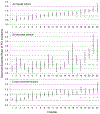Predicting and Surviving Prolonged Critical Illness After Congenital Heart Surgery
- PMID: 32574468
- PMCID: PMC7316132
- DOI: 10.1097/CCM.0000000000004354
Predicting and Surviving Prolonged Critical Illness After Congenital Heart Surgery
Abstract
Objectives: Prolonged critical illness after congenital heart surgery disproportionately harms patients and the healthcare system, yet much remains unknown. We aimed to define prolonged critical illness, delineate between nonmodifiable and potentially preventable predictors of prolonged critical illness and prolonged critical illness mortality, and understand the interhospital variation in prolonged critical illness.
Design: Observational analysis.
Setting: Pediatric Cardiac Critical Care Consortium clinical registry.
Patients: All patients, stratified into neonates (≤28 d) and nonneonates (29 d to 18 yr), admitted to the pediatric cardiac ICU after congenital heart surgery at Pediatric Cardiac Critical Care Consortium hospitals.
Interventions: None.
Measurements and main results: There were 2,419 neonates and 10,687 nonneonates from 22 hospitals. The prolonged critical illness cutoff (90th percentile length of stay) was greater than or equal to 35 and greater than or equal to 10 days for neonates and nonneonates, respectively. Cardiac ICU prolonged critical illness mortality was 24% in neonates and 8% in nonneonates (vs 5% and 0.4%, respectively, in nonprolonged critical illness patients). Multivariable logistic regression identified 10 neonatal and 19 nonneonatal prolonged critical illness predictors within strata and eight predictors of mortality. Only mechanical ventilation days and acute renal failure requiring renal replacement therapy predicted prolonged critical illness and prolonged critical illness mortality in both strata. Approximately 40% of the prolonged critical illness predictors were nonmodifiable (preoperative/patient and operative factors), whereas only one of eight prolonged critical illness mortality predictors was nonmodifiable. The remainders were potentially preventable (postoperative critical care delivery variables and complications). Case-mix-adjusted prolonged critical illness rates were compared across hospitals; six hospitals each had lower- and higher-than-expected prolonged critical illness frequency.
Conclusions: Although many prolonged critical illness predictors are nonmodifiable, we identified several predictors to target for improvement. Furthermore, we observed that complications and prolonged critical care therapy drive prolonged critical illness mortality. Wide variation of prolonged critical illness frequency suggests that identifying practices at hospitals with lower-than-expected prolonged critical illness could lead to broader quality improvement initiatives.
Conflict of interest statement
Disclosures: G.E. Owens is a consultant for HistoSonics. The remaining authors have disclosed they do not have any potential conflicts of interest.
Figures



References
-
- Namachivayam SP, d’Udekem Y, Millar J, et al.: Survival status and functional outcome of children who required prolonged intensive care after cardiac surgery. J Thorac Cardiovasc Surg 2016, 152(4):1104–1112 e1103. - PubMed
-
- Baker-Smith CM, Wilhelm CM, Neish SR, et al.: Predictors of prolonged length of intensive care unit stay after stage I palliation: a report from the National Pediatric Cardiology Quality Improvement Collaborative. Pediatr Cardiol 2014, 35(3):431–440. - PubMed
-
- Mori M, McCracken C, Maher K, et al.: Outcomes of neonates requiring prolonged stay in the intensive care unit after surgical repair of congenital heart disease. J Thorac Cardiovasc Surg 2016, 152(3):720–727 e721. - PubMed
-
- Marcin JP, Slonim AD, Pollack MM, et al.: Long-stay patients in the pediatric intensive care unit. Critical care medicine 2001, 29(3):652–657. - PubMed
Publication types
MeSH terms
Grants and funding
LinkOut - more resources
Full Text Sources
Medical

